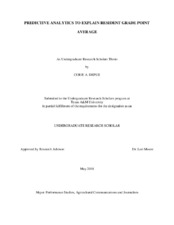| dc.creator | Depue, Corie An | |
| dc.date.accessioned | 2020-07-22T19:51:29Z | |
| dc.date.available | 2020-07-22T19:51:29Z | |
| dc.date.created | 2019-05 | |
| dc.date.issued | 2018-05-04 | |
| dc.date.submitted | May 2019 | |
| dc.identifier.uri | https://hdl.handle.net/1969.1/188510 | |
| dc.description.abstract | Predictive analytics have traditionally been used to anticipate academic standing in college students using variables such as the American College Test (ACT) scores and/or School and College Ability Test (SAT) scores, high-school rank, gender, ethnicity, social cognitive factors, etc. While the use of predictive analytics in higher education has expanded to include variables of identity, such as gender and socioeconomic status, and social and emotional factors, these elements have seldom been explored in the context of housing and residential environment and their impact on academic performance. This study addresses this gap by recommending the inclusion of enrollment level and credit hours to aid in predicting academic performance on-campus. | en |
| dc.format.mimetype | application/pdf | |
| dc.subject | on-campus | en |
| dc.subject | housing | en |
| dc.subject | predictive analytics | en |
| dc.subject | GPR | en |
| dc.subject | GPA | en |
| dc.title | Predictive Analytics to Explain Resident Grade Point Average | en |
| dc.type | Thesis | en |
| thesis.degree.department | Agricultural Leadership, Education, and Communications | en |
| thesis.degree.discipline | Agricultural Communications & Journalism | en |
| thesis.degree.grantor | Undergraduate Research Scholars Program | en |
| thesis.degree.name | BS | en |
| thesis.degree.level | Undergraduate | en |
| dc.contributor.committeeMember | Moore, Lori L | |
| dc.type.material | text | en |
| dc.date.updated | 2020-07-22T19:51:29Z | |


